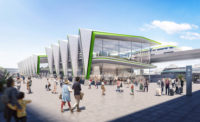Big Orlando Turnout for High-Speed Rail, Despite Gov-elect’s Promise to Spike
Poised to begin spending the first of more than $2 billion in federal dollars for America’s first high-speed rail project on civil work, Florida Dept. of Transportation officials brought together more than 1,500 people interested in participating on the project to inform them about the contracts to be let, the bidding schedule and requirements. However, as U.S.
Sen. Bill Nelson said in Orlando at the first day's session on Nov. 8, “a cloud of uncertainty” hovers over the Florida High Speed Rail Industry Forum in Orlando, with Gov.-elect Rick Scott (R) promising to kill a proposed Orlando-Tampa rail line if any state funding is required.
Acknowledging the elephant in the room, Nelson went on tho accentuate the positive. The rapid-rail link would “spur innovation,” he said. “This could be one of the biggest boosts to Florida’s economy since Disney and Eisenhower created the Interstate system. It will ease congestion and make life better for citizens and the people who fuel our economy.”
Florida began its quest for high-speed rail in the 1970s, but the idea never made significant progress until recently when the state received a pledge of more than $2 billion in federal dollars for the Orlando-to-Tampa train and $8 million to study extending the line to Miami.
Some of the money requires matching dollars from the state. Nelson estimates Florida’s contribution represents 10% of the cost. Assuming the state moves forward with the match, FDOT figures that the project is still short about $350 million and is asking concessionaires interested in bidding on the design-build-operate-maintain and finance (DBOMF) contracts to include that funding in their proposals.
Providing some hope to officials, State Sen. Paula Dockery (R), a long-term supporter of high-speed rail, serves on Scott’s transition team. She spoke at the forum and again voiced her commitment to the project.
“For 21 years, I have been a proponent of high-speed rail,” Dockery says. “I am excited and optimistic that there is no reason to doubt that soon we will break ground on the first high-speed rail [in the United States].”
The first phase, 84 miles from downtown Tampa to Orlando International Airport, includes five stations, with stops in Lakeland, at Walt Disney World and at the Orange County Convention Center.
“Florida will be a national model,” says Karen J. Rae, deputy administrator of the U.S. Dept. of Transportation Federal Railroad Administration. “This is the beginning of a revolution, and you are just foot soldiers.”
Consortiums hoping to receive the contract to design, build, operate, maintain and finance ( DBOMF) the train remained upbeat or declined to comment about the possibility the line will not be built.
Michael C. Turner, a program manager with Skanska USA Civil, part of Florida Rail Ventures, says his team “feels it’s a great project and with the amount of federal funds and the jobs it will create, I’m sure the governor will do due diligence. But we are confident the job will go, given the funding in place.”
The governor-elect is still learning about the project and no one knows at this point what might count toward the state match, adds Howard Newman, a senior project manager with engineering consultant Parsons, which has worked on preliminary engineering for the rail line and plans to bid on early packages and the 30-year DBOMF contract.
Ian Rainey, co-manager of Florida High-Speed Rail, another consortium that includes Fluor and Balfour Beatty, says he is encouraged by Scott’s recent comments in that the governor-elect has been deliberate in his discussions about the rail line.
“He’s not closing down the project, he wants to take a look at the numbers to see if it makes sense,” Rainey says.
Kevin Thibault, assistant secretary for engineering and operations at FDOT, says that he looks forward to sitting down with the governor-elect and discussing the opportunities associated with the project.
“It’s not just about moving people but also creating jobs,” Thibault says.
FDOT estimates that the five early-works contracts, valued at $170 million, will create more than 2,000 jobs in 2011-2012. Four of the contracts will be design-build and the fifth a design-bid-build. Tasks include preparing the medians, some widening of I-4, moving signs, replacing drainage culverts, improving interchanges, and demucking and backfilling a site near Orlando International Airport. All work would begin in 2011 and is scheduled for completion before the concessionaire begins construction of the rail line late in 2012.
The federal government also recently provided an additional $8 million to pay for studies to link the train to Miami, a 220-mile corridor. PB America of New York and Jacobs of Pasadena, Calif., began studying that extension in May 2010.
Regardless of the incoming governor’s decision, FDOT is moving forward, planning to advertise its first early-works package in mid-November and its request for qualifications on the DBOMF contract by early December.


